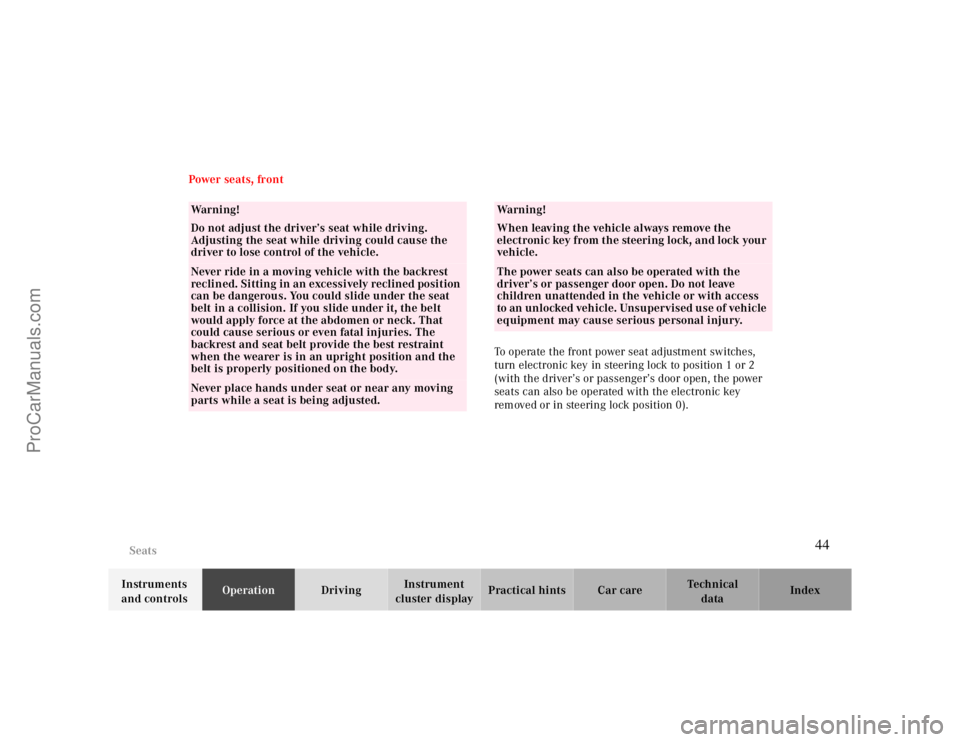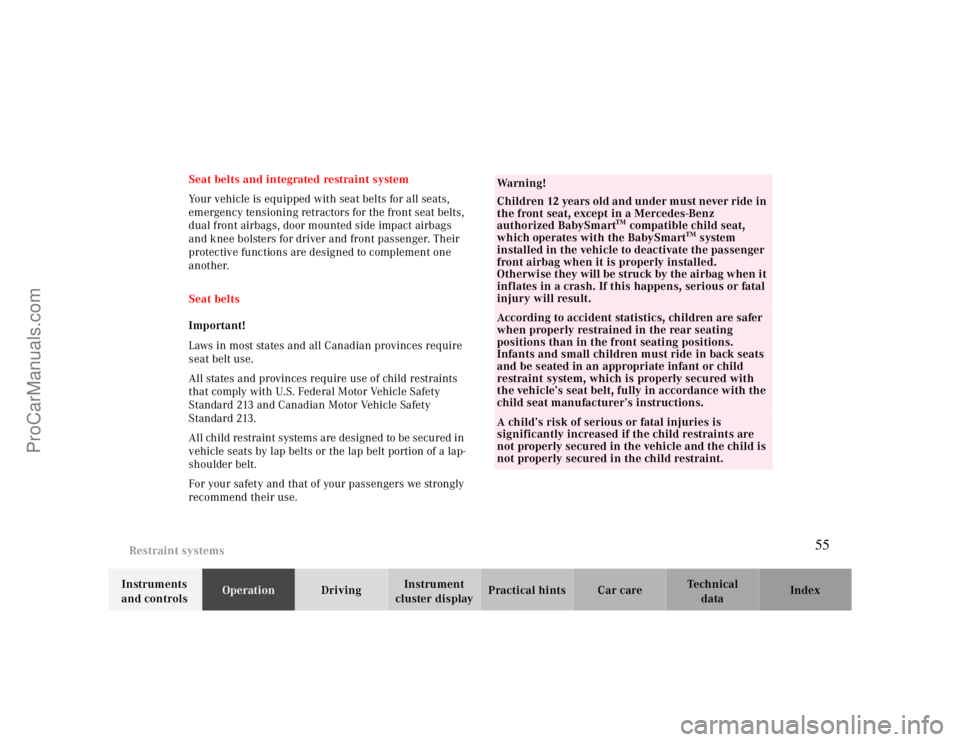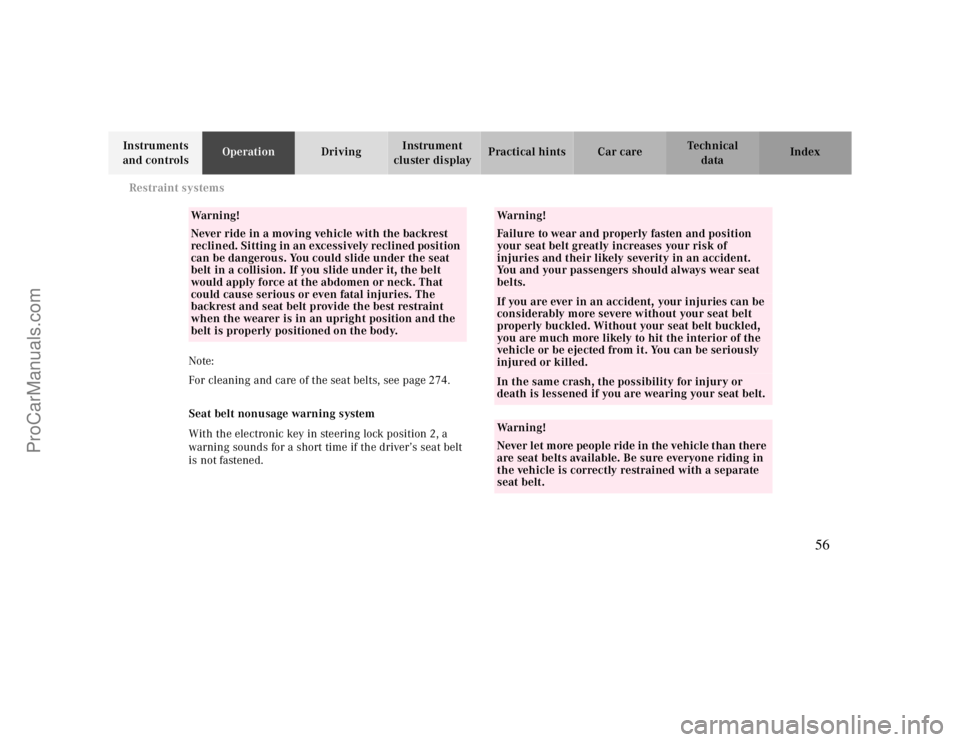2000 MERCEDES-BENZ CLK-CLASS belt
[x] Cancel search: beltPage 3 of 299

IntroductionCentral locking switch 35 Exterior rear view mirrors 75
Product information 7 Automatic central locking 36 Instrument cluster 78
Operator’s manual 8 Emergency unlocking in case of accident 37 Multifunction steering wheel,
Wheretofindit 13 Trunk 38multifunction display
84
Reporting Safety Defects 15 Trunk lid release switch 40Trip and main odometer,
Antitheft alarm system 41 vehicle speed, FSS and engine
Instruments and controlsTow-away alarm 43 oil level indicator 88
Instruments and controls 18 Power seats, front 44
Center console 20 Front head restraints 49 Audio systems 89
Overhead control panel 21 Head restraints, rear 50 Telephone 92
Backrest 51 Navigation system 97
OperationMulticontour seat 52 Trip computer 98
Vehicle keys 24 Heated seats 53 Malfunction message memory 100
Start lock-out 26 Seat belts and integrated restraint system 55 Individual settings 102
General notes on the central
locking system 26Seat belts 55 Setting the audio volume 104
Central locking system 27 Seat belt nonusage warning system 56 Flexible service system (FSS) 105
Radio frequency and infrared
remote control 27BabySmart™ airbag deactivation system 62 Checking engine oil level 108
Locking and unlocking 29 Supplemental restraint system (SRS) 63 Engine oil consumption 109
Choosing global or selective mode
on remote control 29Emergency tensioning retractor (ETR) 63 Exterior lamp switch 110
Opening the trunk 30 Airbags 64 Night security illumination 111
Opening and closing windows
from outside 30Safety guidelines for the seat belt,
emergency tensioning retractor and airbag 69Headlamp cleaning system 112
Panic button 32 Infant and child restraint systems 70 Combination switch 113
Mechanical keys 32 Adjusting telescoping steering column 73 Hazard warning flasher switch 115
Doors
33 Inside rear view mirror 74 Automatic climate control 116
3
ProCarManuals.com
Page 5 of 299

Instrument cluster displayBRAKE FLUID 217 Coolant level 236
PARKING BRAKE 218 Adding coolant 237
Malfunction and indicator lamps in the
instrument cluster 208ENGINE FAN 218 Windshield washer / headlamp
clean.system 238
On-board diagnostic systemCheck engine malfunction indicator lamp
208COOLANT (coolant level) 219 Windshield and headlamp
washer fluid mixing ratio 238
Brake warning lamp 209 COOLANT (coolant temp.) 220 Wheels 239
Supplemental restraint system STEER. WHEEL ADJUST. 221 Tire replacement 239
(SRS) indicator lamp 210 LIGHT SENSOR 221 Rotating wheels 240
Fuel reserve and fuel cap LIGHTING SYSTEM 222 Spare wheel 241
placement warning 210 WASHER FLUID 223 Changing wheels 242
Electronic stability program(ESP) OIL TEMP. (engine oil temperature) 224 Tire inflation pressure 247
warning lamp 211 ENGINE OIL LEVEL 224 Battery 249
BAS/ESP malfunction indicator lamp 211 ELEC. STABIL. PROG. (Electronic Jump starting 251
ABS malfunction indicator lamp 211 stability program) 226 Towing the vehicle 253
Telescoping steering column – Transmission selector lever,
indicator lamp 212
Practical hintsmanually unlocking 255
Seat belt warning lamp 212 Bulbs 256
Malfunction and indicator lamps in the First aid kit 228 Adjusting headlamp aim 261
center console 212 Shelf below rear window 228 Changing batteries in the
AIRBAG OFF indicator lamp 212 Stowing things in the vehicle 228 electronic main key 264
Roll bar warning lamp 221 Spare wheel, vehicle tools, storage Synchronizing remote control 266
Malfunction and warning messages in compartment 229 Emergency operation of
the multifunction display 213 Vehicle jack 230 sliding/pop-up roof 267
DISPLAY DEFECTIVE 214 Fuses 231
Manual release for fuel filler flap
268
BATTERY/ALTERNATOR 215 Hood 233 Replacing wiper blade insert 268
ABS-SYSTEM 216 Checking engine oil level 234 Trunk lamp 270
BRAKE ASSIST 216 Automatic transmission fluid level 236 Roof rack 270
BRAKE LINING WEAR 217
5
ProCarManuals.com
Page 6 of 299

Vehicle care Technical data
Cleaning and care of the vehicle 272 Spare parts service 278
Engine cleaning 273 Warranty coverage 278
Vehicle washing 273 Identification labels 279
Plastic and rubber parts 273 Layout of poly-V-belt drive 280
Tar stains 274 Technical data 281
Window cleaning 274 Fuels, coolants, lubricants etc. –
capacities 284
Headlamps, taillamps, turn signal Engine oils additives 285
lenses 274 Engine oil 285
Wiper blade 274 Air conditioner refrigerant 285
Seat belts 274 Brake fluid 285
Headliner and shelf below rear window 275 Premium unleaded gasoline 286
Instrument cluster 275 Fuel requirements 286
Steering wheel and gear selector lever 275 Gasoline additives 287
Hard plastic trim items 275 Coolants 287
Upholstery 275 Consumer information 289
Paintwork, painted body components 276 Uniform tire quality grading 289
Light alloy wheels 276
Ornamental Moldings 276
Index291
6
ProCarManuals.com
Page 22 of 299

Operation
Tow-away alarm 43 Multifunction steering wheel,
Power seats, front 44multifunction display
84
Vehicle keys 24 Front head restraints 49Trip and main odometer, vehicle
speed, FSS and engine
Start lock-out 26 Head restraints, rear 50 oil level indicator 88
General notes on the central
locking system 26Backrest 51 Audio systems 89
Central locking system 27 Multicontour seat 52 Telephone 92
Radio frequency and infrared
remote control 27Heated seats 53 Navigation system 97
Locking and unlocking 29 Seat belts and integrated restraint system 55 Trip computer 98
Choosing global or selective mode
on remote control 29Seat belts 55 Malfunction message memory 100
Opening the trunk 30 Seat belt nonusage warning system 56 Individual settings 102
Opening and closing windows
from outside 30BabySmart™ airbag deactivation system 62 Setting the audio volume 104
Panic button 32 Supplemental restraint system (SRS) 63 Flexible service system (FSS) 105
Mechanical keys 32 Emergency tensioning retractor (ETR) 63 Checking engine oil level 108
Doors 33 Airbags 64
Central locking switch 35 Safety guidelines for the seat belt,
emergency tensioning retractor and airbag 69
Automatic central locking 36 Infant and child restraint systems 70
Emergency unlocking in case of Adjusting telescoping steering column 73
accident 37 Inside rear view mirror 74
Trunk 38 Exterior rear view mirrors 75
Trunk lid release switch 40 Instrument cluster 78
Antitheft alarm system 41
22
ProCarManuals.com
Page 44 of 299

Seats
Te ch n ica l
data Instruments
and controlsOperationDrivingInstrument
cluster displayPractical hints Car care Index Power seats, front
To operate the front power seat adjustment switches,
turn electronic key in steering lock to position 1 or 2
(with the driver’s or passenger’s door open, the power
seats can also be operated with the electronic key
removed or in steering lock position 0).
Warning!
Do not adjust the driver’s seat while driving.
Adjusting the seat while driving could cause the
driver to lose control of the vehicle.Never ride in a moving vehicle with the backrest
reclined. Sitting in an excessively reclined position
can be dangerous. You could slide under the seat
belt in a collision. If you slide under it, the belt
would apply force at the abdomen or neck. That
could cause serious or even fatal injuries. The
backrest and seat belt provide the best restraint
when the wearer is in an upright position and the
belt is properly positioned on the body.Never place hands under seat or near any moving
parts while a seat is being adjusted.
Wa r n i n g !
When leaving the vehicle always remove the
electronic key from the steering lock, and lock your
vehicle.The power seats can also be operated with the
driver’s or passenger door open. Do not leave
children unattended in the vehicle or with access
to an unlocked vehicle. Unsupervised use of vehicle
equipment may cause serious personal injury.
44
ProCarManuals.com
Page 48 of 299

Seats
Te ch n ica l
data Instruments
and controlsOperationDrivingInstrument
cluster displayPractical hints Car care Index Important!
Prior to operating the vehicle, the driver should adjust
the seat height for proper vision as well as fore/aft
placement and backrest angle to insure adequate
control, reach, operation, and comfort. The head
restraint should also be adjusted for proper height. See
also airbag section on page64 for proper seat
positioning.
In addition, also adjust the steering wheel to ensure
adequate control, reach, operation, and comfort.
Both the inside and outside rear view mirrors should be
adjusted for adequate rearward vision.
Fasten seat belts. Infants and small children should be
seated in a properly secured restraint system that
complies with U.S. Federal Motor Vehicle Safety
Standard 213 and Canadian Motor Vehicle Safety
Standard 213.
All seat, head restraint, steering wheel, and rear view
mirror adjustments as well as fastening of seat belts
should be done before the vehicle is put into motion.
Wa r n i n g !
Children 12 years old and under must never ride in
the front seat, except in a Mercedes-Benz
authorized BabySmart
TM compatible child seat,
which operates with the BabySmart
TM system
installed in the vehicle to deactivate the passenger
side front airbag when it is properly installed.
Otherwise they will be struck by the airbag when it
inflates in a crash. If this happens, serious or fatal
injury can result.
According to accident statistics, children are safer
when properly restrained in the rear seating
positions than in the front seating positions.
Infants and small children must ride in back seats
and be seated in an appropriate infant or child
restraint system, which is properly secured with
the vehicle’s seat belt, fully in accordance with the
child seat manufacturer’s instructions.A child’s risk of serious or fatal injuries is
significantly increased if the child restraints are
not properly secured in the vehicle and the child is
not properly secured in the child restraint.
48
ProCarManuals.com
Page 55 of 299

Restraint systems
Te ch n ica l
data Instruments
and controlsOperationDrivingInstrument
cluster displayPractical hints Car care Index Seat belts and integrated restraint system
Your vehicle is equipped with seat belts for all seats,
emergency tensioning retractors for the front seat belts,
dual front airbags, door mounted side impact airbags
and knee bolsters for driver and front passenger. Their
protective functions are designed to complement one
another.
Seat belts
Important!
Laws in most states and all Canadian provinces require
seat belt use.
All states and provinces require use of child restraints
that comply with U.S. Federal Motor Vehicle Safety
Standard 213 and Canadian Motor Vehicle Safety
Standard 213.
All child restraint systems are designed to be secured in
vehicle seats by lap belts or the lap belt portion of a lap-
shoulder belt.
For your safety and that of your passengers we strongly
recommend their use.
Wa r n i n g !
Children 12 years old and under must never ride in
the front seat, except in a Mercedes-Benz
authorized BabySmart
TM compatible child seat,
which operates with the BabySmart
TM system
installed in the vehicle to deactivate the passenger
front airbag when it is properly installed.
Otherwise they will be struck by the airbag when it
inflates in a crash. If this happens, serious or fatal
injury will result.
According to accident statistics, children are safer
when properly restrained in the rear seating
positions than in the front seating positions.
Infants and small children must ride in back seats
and be seated in an appropriate infant or child
restraint system, which is properly secured with
the vehicle’s seat belt, fully in accordance with the
child seat manufacturer’s instructions.A child’s risk of serious or fatal injuries is
significantly increased if the child restraints are
not properly secured in the vehicle and the child is
not properly secured in the child restraint.
55
ProCarManuals.com
Page 56 of 299

Restraint systems
Te ch n ica l
data Instruments
and controlsOperationDrivingInstrument
cluster displayPractical hints Car care Index
Note:
For cleaning and care of the seat belts, see page274.
Seat belt nonusage warning system
With the electronic key in steering lock position 2, a
warning sounds for a short time if the driver’s seat belt
is not fastened.
Warning!
Never ride in a moving vehicle with the backrest
reclined. Sitting in an excessively reclined position
can be dangerous. You could slide under the seat
belt in a collision. If you slide under it, the belt
would apply force at the abdomen or neck. That
could cause serious or even fatal injuries. The
backrest and seat belt provide the best restraint
when the wearer is in an upright position and the
belt is properly positioned on the body.
Wa r n i n g !
Failure to wear and properly fasten and position
your seat belt greatly increases your risk of
injuries and their likely severity in an accident.
You and your passengers should always wear seat
belts.If you are ever in an accident, your injuries can be
considerably more severe without your seat belt
properly buckled. Without your seat belt buckled,
you are much more likely to hit the interior of the
vehicle or be ejected from it. You can be seriously
injured or killed.In the same crash, the possibility for injury or
death is lessened if you are wearing your seat belt.Wa r n i n g !
Never let more people ride in the vehicle than there
are seat belts available. Be sure everyone riding in
the vehicle is correctly restrained with a separate
seat belt.
56
ProCarManuals.com